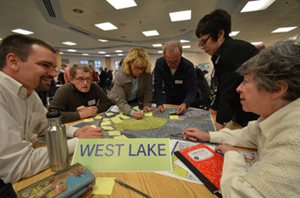Counties often lead corridor and station area planning in coordination with cities located along a future transitway. These efforts build local support for the transitway, help decision-making on design and engineering, and identify potential needs and opportunities for development and infrastructure. Members of the public, as well as stakeholder groups and local policymakers, participate in these efforts and provide oversight. They help inform changes in local policy, community development regulations, and city and county capital improvement programs.
Corridor and station area planning typically covers the following scope of work:
-
Market studies and analysis of near-term and long-term development opportunities
-
Urban design analysis and recommendations for improvements
-
Analysis of pedestrian and bicycle connections and improvement recommendations
-
Recommended policy changes and steps for implementation
 The Community Works program supports corridor and station area planning in Hennepin County. The program invests time and resources in transportation corridors, including all major transitways in Hennepin County. Conducted with an interdisciplinary and collaborative approach, program activities support public participation, planning studies, and funding for infrastructure improvements.
The Community Works program supports corridor and station area planning in Hennepin County. The program invests time and resources in transportation corridors, including all major transitways in Hennepin County. Conducted with an interdisciplinary and collaborative approach, program activities support public participation, planning studies, and funding for infrastructure improvements.
Information about the corridor and station area planning can be found at: